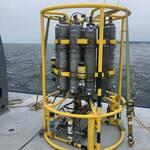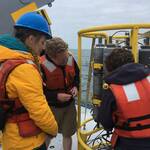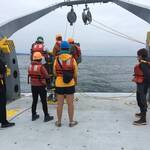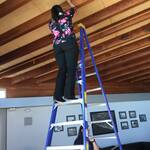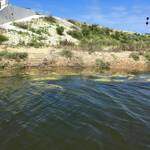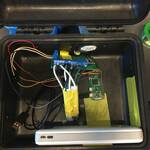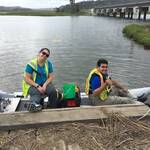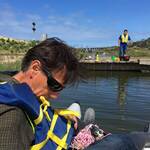12 June 2019 Alex Horner-Devine and Jim Thomson’s (UW) graduate student Sam Kastner defended his general exam, he is making great progress towards defending his dissertation! To followup this event, we held a mini symposium at UW on wave-plume interactions on 13 June 2019. Angelica joined us remotely. It was an incredibly fruitful day filled with in-depth discussions about wave-plume interactions, relevant parameter space, measurement and modeling techniques, and more.
Isabella Arzeno awarded prestigious Ford Foundation Fellowship!
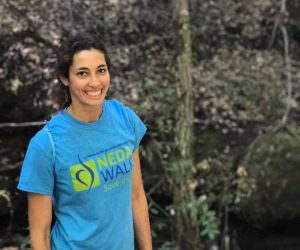 Congratulations to Isabella Arzeno! Isa was awarded the prestigious Ford Foundation Dissertation Year Fellowship. Ford Foundation Fellowship programs (administered through the National Academies of Sciences, Engineering, & Medicine) aim to increase the diversity of the US college and university faculties by “increasing their ethnic and racial diversity, maximize the educational benefits of diversity, and increase the number of professors who can and will use diversity as a resource for enriching the education of all students”. See here for a Ford Foundation 2019 Fellows press release.
Congratulations to Isabella Arzeno! Isa was awarded the prestigious Ford Foundation Dissertation Year Fellowship. Ford Foundation Fellowship programs (administered through the National Academies of Sciences, Engineering, & Medicine) aim to increase the diversity of the US college and university faculties by “increasing their ethnic and racial diversity, maximize the educational benefits of diversity, and increase the number of professors who can and will use diversity as a resource for enriching the education of all students”. See here for a Ford Foundation 2019 Fellows press release.
Student R/V Sproul cruise
01 June 2019 – SIO 176, Observational Physical Oceanography class, Spring 2019, class cruise! Giddings was invited to join Fiamma Straneo’s SIO 176 cruise aboard the R/V Robert Gordon Sproul. The cruise was intended to give the students a taste for field work and to test out the CTDs that they designed and built during the class! It was a beautiful, calm day out on the water and the students really enjoyed experiencing fieldwork first hand. Two of the student-built CTDs collected data and two remained water tight to depths of 50m!
- ready to go!
- attaching student-built sensors to the CTD rosette
- watching as the CTDs are taken off after a cast
Angelica Rodriguez defends her PhD!
24 May 2019, Angelica successfully defended her PhD, congratulations to the new Doctor!!!
- research-themed cookies
- and an amazing boogie-board ADCP research themed cake!
- a toast to the newly minted PhD
- signing the SIO surfside rafters
Tijuana NERR speaker series – this Saturday!
Come learn about the CSIDE project and some of Sarah and the lab’s work as it pertains to coastal pollution transport and estuarine/coastal exchange at the Tijuana River National Estuarine Research Reserve (TRNERR) speaker series! The talk is Saturday 20 April, 2019 starting at 10am at the TRNERR reserve, for more information please see the TRNERR event information and flyer.
oyster biosensor test deployment!
On 02 April 2019 we deployed our first prototype oyster biosensors which will measure shell gape at the same time as we are measuring the hydrodynamic and oxygen conditions. The deployment itself required some last minute MacGyvering, but we got it done! The estuary mouth started to close on 12 August 2019 in response to large waves the prior night, and is currently completely closed and filling in with fresher water from upstream. We returned yesterday, 16 April 2019 to swap out the biosensor battery and SD card to capture data over the closure. A first quick look at the first week of data looks good! More information on this project and the undergraduate research here!
- 16 April 2019, the algae has started growing since the estuary closure!
- prototype sensor electronics
- prototype sensors on oysters
- loading the truck for deployment
- laying out the mooring on the dock
- Maddie and Adrian ready to go swap batteries
- Carlos Niera prepping to collect water samples
- out on LPL
- loading the boat for deployment
participation in SD Climate Summit
Our lab participated in the 2019 San Diego Climate Summit on March 26, 2019. Sarah gave a talk on estuarine response to shoreline change and Angelica and Maddie set up a table and presented our work to interested attendees. We forgot to take photos, but some should be coming soon on the summit website!
7th Seychelles field trip!
A weary set of travelers returned from the Seychelles yesterday. This trip marked the 7th trip our SLOMO group has completed! As usual, we recovered instrumentation and met with local agencies. A departure from usual – some of our longer-term moorings were not-redeployed. However we did still redeploy several instruments around Mahé. Isa is busily plugging away at her ongoing analysis of dynamics around and atop the plateau, while new postdoctoral scholar, Alma is working to write a summary paper of the dynamics atop the plateau.
Tropical reef momentum budget
Graduate student Isabella Arzeno just published the first chapter of her dissertation on examining the dynamics over coral reefs. While prior dynamical studies over coral reefs have predominantly focused on cross‐reef dynamics, this manuscript examines the along-shore dynamics. This is done through using observations of a Hawaiian fringing reef system to quantify the dominant terms in the depth‐averaged alongshore momentum budget as a function of tidal phase. Importantly, while the canonical balance is important, the observations also suggest the importance of advective acceleration at one of the sites – a term often ignored.
Southern CA coastal response to the last El Niño
With an El Niño watch ongoing this winter, this recent publication with lead author Adam Young looks back at the 2015-2016 El Niño response along the Southern California coastline, particularly focusing on the morphodynamic changes (erosion/accretion) seen along our beaches, estuaries, and cliffs. Key findings are that the coastal change is highly variable spatially with some regions showing erosion, some showing accretion, and the average being moderate erosion. The relatively moderate response is attributed to the wave angle and the coastline shape sheltering Southern California from the largest waves, minimal rainfall, and the fortunate asynchronous timing of the largest waves and largest tides. Investigating how the 2015-2016 El Niño impacts our coastlines gives us an idea of how our coasts may be affected under future climate scenarios where similar storm tracks and wave angles are predicted.

